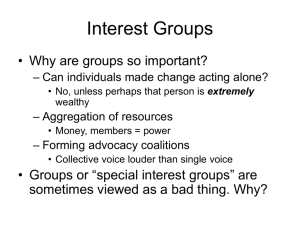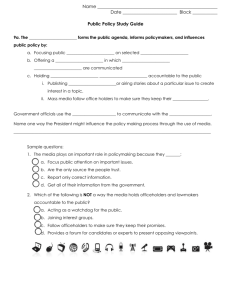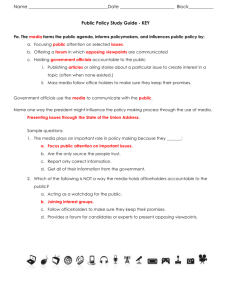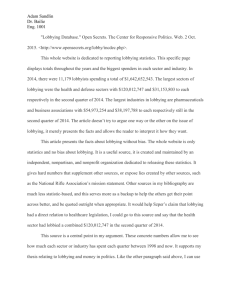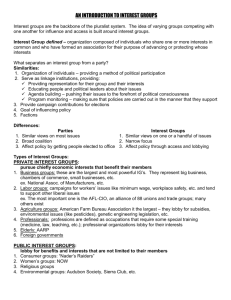Chapter 9 Review Worksheet
advertisement
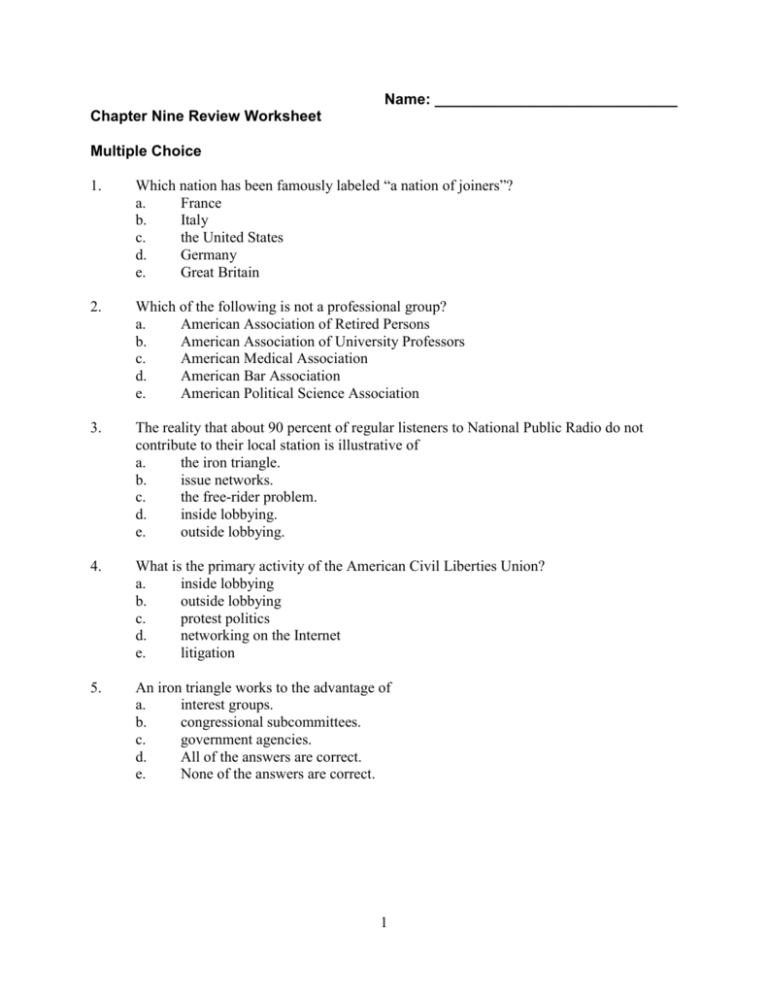
Name: _____________________________ Chapter Nine Review Worksheet Multiple Choice 1. Which nation has been famously labeled “a nation of joiners”? a. France b. Italy c. the United States d. Germany e. Great Britain 2. Which of the following is not a professional group? a. American Association of Retired Persons b. American Association of University Professors c. American Medical Association d. American Bar Association e. American Political Science Association 3. The reality that about 90 percent of regular listeners to National Public Radio do not contribute to their local station is illustrative of a. the iron triangle. b. issue networks. c. the free-rider problem. d. inside lobbying. e. outside lobbying. 4. What is the primary activity of the American Civil Liberties Union? a. inside lobbying b. outside lobbying c. protest politics d. networking on the Internet e. litigation 5. An iron triangle works to the advantage of a. interest groups. b. congressional subcommittees. c. government agencies. d. All of the answers are correct. e. None of the answers are correct. 1 6. Most political action committees represent a. citizens’ groups. b. government groups. c. business groups. d. labor groups. e. incumbent office holders. 7. _____ wrote that “Liberty is to faction what air is to fire.” a. James Madison b. Theodore Lowi c. John McCain d. Bob Livingston e. John Stuart Mill 8. The interest group system a. has a working-class bias. b. has a middle-class bias. c. has an upper-class bias. d. has a liberal bias. e. has a conservative bias. 9. The largest labor union in 1950 was a. the National Education Association. b. the International Brotherhood of Teamsters. c. the Service Employees International. d. the United Auto Workers. e. the United Steel Workers. 10. The largest labor union in 2000 was a. the National Education Association. b. the United Auto Workers. c. the International Association of Machinists. d. the American Federation of State, County, and Municipal Employees. e. the International Brotherhood of Teamsters. 11. Congress receives more mail from members of _____ than it does from members of any other group. a. the American Civil Liberties Union b. Greenpeace c. Common Cause d. the American Association of Retired Persons e. MoveOn 2 12. Political action committees can contribute _____ per candidate per election under federal law (counting primary and general elections separately). a. $1,000 b. $5,000 c. $25,000 d. $50,000 e. $100,000 13. “The size factor” advantages a. public interest groups. b. business groups. c. labor unions. d. environmental interest groups. e. None of the answers are correct. 14. The National Rifle Association is a. a public interest group. b. a single-issue group. c. an ideological group. d. both a public interest and a single-issue group. e. None of the answers are correct. 15. Which of the following is a disadvantage for citizens’ groups? a. A citizen group has to continually raise funds. b. A citizen group has to contend with the free-rider problem. c. Its members don’t usually receive material benefits. d. None of the answers are correct. e. All of the answers are correct. 16. Which part of Washington, D.C. is populated almost entirely by lobbying firms? a. C Street b. New Jersey Avenue c. 13th Street d. Pennsylvania Avenue e. K Street 17. What do the Christian Coalition, the National Organization for Women, and the National Association for the Advancement of Colored People have in common? a. They are all dominated by conservatives. b. They are all dominated by Democrats. c. They are all dominated by conservatives and Democrats. d. They are all ideological groups. e. They are all economic groups. 3 18. What new development has helped citizens’ groups to overcome the free-rider problem and reach more donors? a. computer-assisted mailing lists b. e-mail lists c. websites d. All of the answers are correct. e. None of the answers are correct. 19. Which of the following groups routinely engage in lobbying? a. National Rifle Association b. National Organization for Women c. U.S. Conference of Mayors d. National Governors Conference e. All of the answers are correct. 20. Who coined the term “interest group liberalism”? b. Madison c. Lowi d. de Tocqueville e. Schattschneider e. Jefferson Essays 21. What are the four general types of economic groups? 22. What are the three general types of citizens’ groups? 23. What are the targets of inside lobbying? 4 24. Identify and explain two flaws in pluralist theory. 25. How do interest groups pose a Madisonian dilemma in American politics? 5


